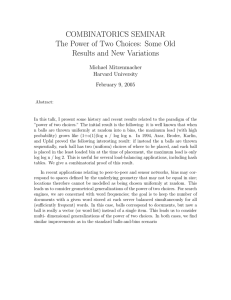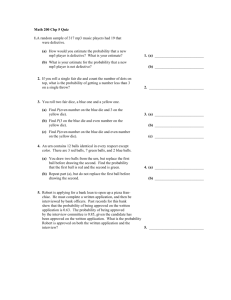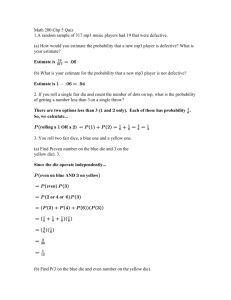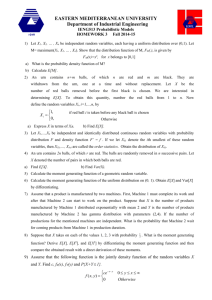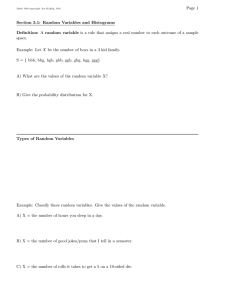Probability I Sample spaces, outcomes, and events.
advertisement
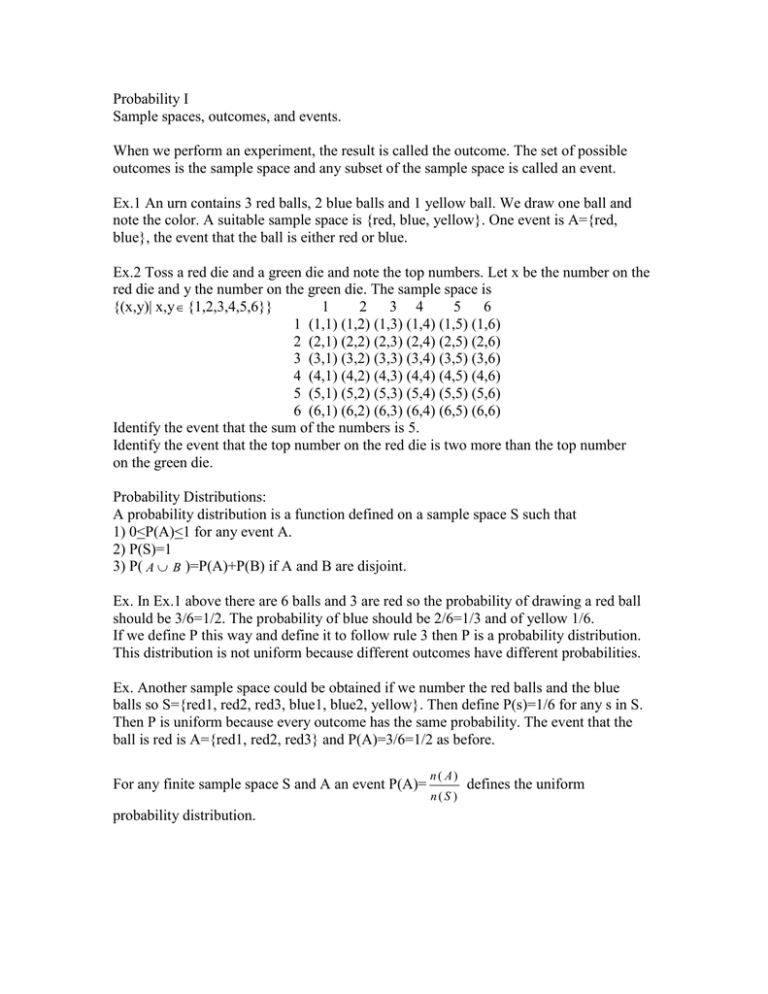
Probability I
Sample spaces, outcomes, and events.
When we perform an experiment, the result is called the outcome. The set of possible
outcomes is the sample space and any subset of the sample space is called an event.
Ex.1 An urn contains 3 red balls, 2 blue balls and 1 yellow ball. We draw one ball and
note the color. A suitable sample space is {red, blue, yellow}. One event is A={red,
blue}, the event that the ball is either red or blue.
Ex.2 Toss a red die and a green die and note the top numbers. Let x be the number on the
red die and y the number on the green die. The sample space is
{(x,y)| x,y {1,2,3,4,5,6}}
1
2
3 4
5
6
1 (1,1) (1,2) (1,3) (1,4) (1,5) (1,6)
2 (2,1) (2,2) (2,3) (2,4) (2,5) (2,6)
3 (3,1) (3,2) (3,3) (3,4) (3,5) (3,6)
4 (4,1) (4,2) (4,3) (4,4) (4,5) (4,6)
5 (5,1) (5,2) (5,3) (5,4) (5,5) (5,6)
6 (6,1) (6,2) (6,3) (6,4) (6,5) (6,6)
Identify the event that the sum of the numbers is 5.
Identify the event that the top number on the red die is two more than the top number
on the green die.
Probability Distributions:
A probability distribution is a function defined on a sample space S such that
1) 0<P(A)<1 for any event A.
2) P(S)=1
3) P( A B )=P(A)+P(B) if A and B are disjoint.
Ex. In Ex.1 above there are 6 balls and 3 are red so the probability of drawing a red ball
should be 3/6=1/2. The probability of blue should be 2/6=1/3 and of yellow 1/6.
If we define P this way and define it to follow rule 3 then P is a probability distribution.
This distribution is not uniform because different outcomes have different probabilities.
Ex. Another sample space could be obtained if we number the red balls and the blue
balls so S={red1, red2, red3, blue1, blue2, yellow}. Then define P(s)=1/6 for any s in S.
Then P is uniform because every outcome has the same probability. The event that the
ball is red is A={red1, red2, red3} and P(A)=3/6=1/2 as before.
For any finite sample space S and A an event P(A)=
probability distribution.
n ( A)
n(S )
defines the uniform
Ex. The urn is the same as before. Suppose the experiment is to draw two balls and note
the color. The sample space is all the 2-element subsets of S. P is uniform.
How many elements are in the sample space? How many ways can you draw 2 balls out
of 6? C(6,2)=15.
What is the probability of drawing 2 red balls? Since P is uniform this is the number of
ways to draw two red balls divided by the number of ways to draw any two balls.
How many ways can you draw 2 red balls out of 3? C(3,2)=3
P(2 red balls)=3/15=1/5
Ex. Now the experiment is to draw 3 balls out of the urn. What is the probability of
getting exactly 2 red balls?
How many ways can you draw 3 balls with exactly two of them red?
We can draw 2 red balls in C(3,2)=3 ways and then we have to draw a 3rd ball. There
are 3 non-red balls so we have 3 ways to draw the 3rd ball. Using the multiplication
principle we have 3x3=9 ways to choose exactly 2 red balls and one other.
How many can we choose 3 balls out of the urn? C(6,3)=20
P(2 red balls)=9/20
Ex. Toss two dice and observe the top numbers. P is uniform. What is the probability
that the sum is 7? In the chart of example 2 there are 6 entries with a sum of 7 so the
probability is 6/36=1/6.
Relative Frequency:
Perform an experiment n times and note the frequency of each outcome.
P(s)=the number of times s occurs divided by n=the relative frequency of s
Ex. A 5-point quiz is given to 120 students with the following results
Score 1
2
3
4
5
Frequency 15 10
35 45 15 total=120 Divide each by 120.
Relative
1/8 1/12 7/24 3/8 1/8
Frequency
P(a score is between 3 and 5 inclusive)=7/24 + 3/8 + 1/8 = 19/24
Ex. A die is tossed repeatedly with the following results.
1
2
3
4
5 6
frequency.55 45 32 27 26 15 The total of the frequencies is 200. Compute
the relative frequencies by dividing the frequencies by 200. For the relative frequency
distribution, P(the number is either 1 or 2)=(55+45)/200 =.5
Perhaps this is not an evenly weighted die.
Rules of Probability:
1. P(A B)=P(A) + P(B) if A and B are disjoint.
2. P(A C )=1-P(A)
3. P(A B)=P(A) + P(B) – P(A B)
Ex. An urn contains 3 red balls , 2 blue balls and 1 yellow ball. Draw 3 without
replacement. What is the probability of getting at least 2 red balls?
We break up the event “ at least 2 red” into two disjoint pieces “exactly 2 red” and
“exactly 3 red”. Then use rule 1, the addition rule.
We saw earlier that P(exactly 2 red) =9/20
There is only one way to get exactly 3 red so P(exactly 3 red)=1/20
P(at least 2 red)=9/20 +1/20=.5
Ex. For the same experiment what is the probability of getting at most one red ball?
The complement of “at most one red ball” is “at least two red balls”.
Using rule 2, the complement rule we have P(at most one red ball)=1-.5=.5
As an exercise, figure this probability with the addition rule.
Ex. What is the probability of getting at least one red ball?
The complement of “at least one red ball” is “no red balls”. The probability of no red
balls is C(3,3)/C(6,3) = 1/20 P(at least one red ball)=1-1/20 =19/20
Students often ask “When do you multiply and when do you add?”.
Multiply when you must do task A and task B and each way of doing A can be paired
with each way of doing B. That is the multiplication principle.
Add when you must do either A or B and A and B are disjoint.
Ex. For rule 3. Toss 2 dice. What is the probability that at least one is a 6?
P(6 on red)=6/36=1/6 P(6 on green)=1/6 P(6 on both)=1/36
P(at least one 6)= 1/6 +1/6 -1/36 =11/36
More Examples
Ex. Toss a fair coin 10 times. What is the probability of exactly 5 heads?
How many ways can you get 5 heads? Think of a 10 letter word of H’s and T’s.
We have to choose 5 spaces for the 5 heads and the rest of the spaces will be T’s
There are C(10,5)=252 ways to choose 5 out of 10 spaces.
There are 2 10 =1024 equally likely outcomes. P(exactly 5 heads)=252/1024 =.246
Ex. Toss a fair coin 10 times. What is the probability of 4, 5, or 6 heads?
(C(10,4) + C(10,5) + C(10,6))/1024 =.65625
Ex. Again toss a fair coin 10 times. What is the probability of at least one H?
The complement of “at least one H” is “no H’s” or “all T’s” so
P(at least one H)=1-P(0 H’s)=1-1/1024 =.999…
Ex. Some students took an exam. Using the relative frequency distribution with x
representing a random exam score it was found that P(x>70)=.5 and P(x>80)=.2.
What is P(70<x<80)? .5-.2=.3 Draw a Venn diagram to show this.
Ex. A crate of oranges contains 50 oranges and 4 of them are rotten. 10 oranges are
selected at random. What is the probability of getting 8 good and 2 bad oranges?
46 good | 4 bad
choose 8
| choose 2
How many ways can we choose 8 good out of 46 and also choose 2 bad out of 4?
C(46,8)C(4,2) We used the multiplication principle because we do both.
How many ways can we choose 10 oranges out of 50?
C(50,10)
P(8 good and 2 bad)=C(46,8)C(4,2)/C(50,1
Ex. The birthday problem
In a group of 10 people, what is the probability that at least 2 of them have the same
birthday?
We first look at the complement event. What is the probability that all have different
birthdays?
How many ways can you assign 10 out of 365 birthdays to 10 people with no repeats?
P(365,10) Ignoring Feb 29
How many ways can you assign birthdays, repeats allowed, to 10 people?
365 10
P(all different birthdays)=P(365,10)/365 10 =.88305…
P(at least two have the same birthday)=1-.88305…=.116948…
Ex. A multiple choice test has 12 questions each with 1 correct answer and 3 incorrect
answers. If a person guesses randomly, what is the probability of getting at least 10
questions correct?
“at least 10” means “exactly 10” or “exactly 11” or “exactly 12” which are disjoint.
n(at least 10 correct)=n(exactly 10 correct)+n(exactly 11 correct)+n(exactly 12 correct)
n(exactly 10 correct) is computed as follows:
There C(12,10) ways to choose which 10 are correct. There is one way to answer these
10 questions so they are all correct. We have to also answer the two incorrect questions
and each has 3 incorrect answers. That makes 3x3=9 ways to answer the two incorrect
questions.
We have C(12,10)x9 ways to choose the 10 correct and answer the other two
incorrectly.
n(exactly 11 correct) is similar.
We have C(12,11)x3 ways to choose the 11 correct and answer the other one
incorrectly.
Lastly there is one way to get all 12 correct.
n(at least 10 correct)=C(12,10)x9 + C(12,11)x3 + 1=631
How many ways can you answer the test in general? 4 12
P(at least 10 correct)=631/4 12 =.0000376

